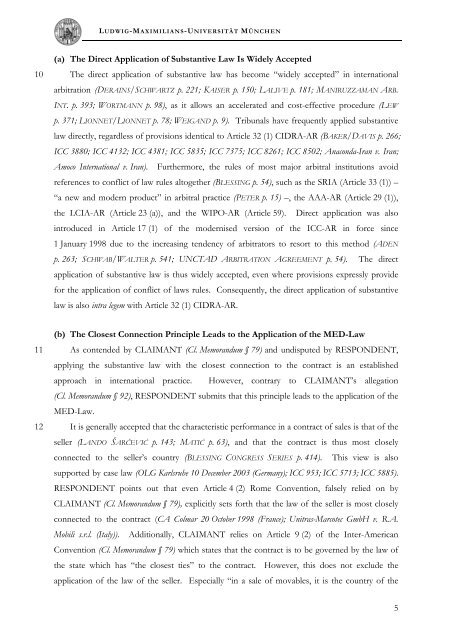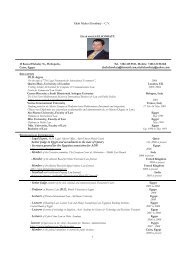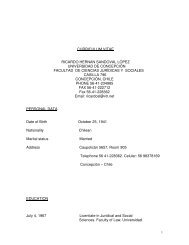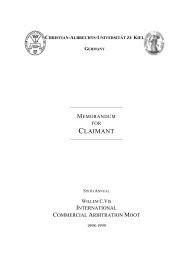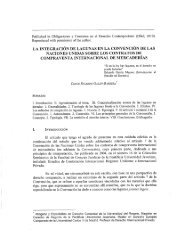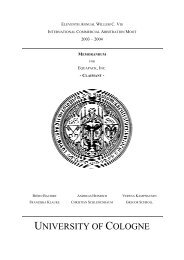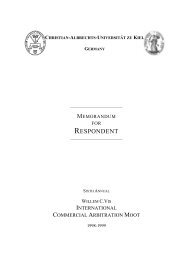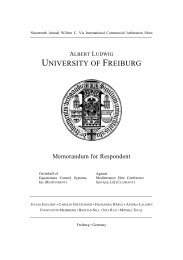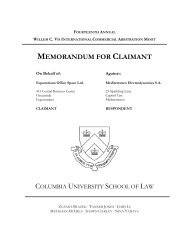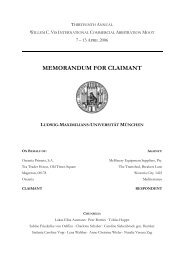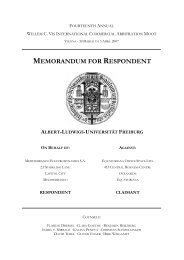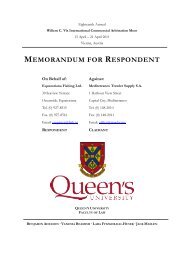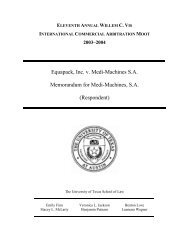memorandum for respondent ludwig-maximilians-universität münchen
memorandum for respondent ludwig-maximilians-universität münchen
memorandum for respondent ludwig-maximilians-universität münchen
You also want an ePaper? Increase the reach of your titles
YUMPU automatically turns print PDFs into web optimized ePapers that Google loves.
LUDWIG-MAXIMILIANS-UNIVERSITÄT MÜNCHEN<br />
(a) The Direct Application of Substantive Law Is Widely Accepted<br />
10 The direct application of substantive law has become “widely accepted” in international<br />
arbitration (DERAINS/SCHWARTZ p. 221; KAISER p. 150; LALIVE p. 181; MANIRUZZAMAN ARB.<br />
INT. p. 393; WORTMANN p. 98), as it allows an accelerated and cost-effective procedure (LEW<br />
p. 371; LIONNET/LIONNET p. 78; WEIGAND p. 9). Tribunals have frequently applied substantive<br />
law directly, regardless of provisions identical to Article 32 (1) CIDRA-AR (BAKER/DAVIS p. 266;<br />
ICC 3880; ICC 4132; ICC 4381; ICC 5835; ICC 7375; ICC 8261; ICC 8502; Anaconda-Iran v. Iran;<br />
Amoco International v. Iran). Furthermore, the rules of most major arbitral institutions avoid<br />
references to conflict of law rules altogether (BLESSING p. 54), such as the SRIA (Article 33 (1)) –<br />
“a new and modern product” in arbitral practice (PETER p. 15) –, the AAA-AR (Article 29 (1)),<br />
the LCIA-AR (Article 23 (a)), and the WIPO-AR (Article 59). Direct application was also<br />
introduced in Article 17 (1) of the modernised version of the ICC-AR in <strong>for</strong>ce since<br />
1 January 1998 due to the increasing tendency of arbitrators to resort to this method (ADEN<br />
p. 263; SCHWAB/WALTER p. 541; UNCTAD ARBITRATION AGREEMENT p. 54). The direct<br />
application of substantive law is thus widely accepted, even where provisions expressly provide<br />
<strong>for</strong> the application of conflict of laws rules. Consequently, the direct application of substantive<br />
law is also intra legem with Article 32 (1) CIDRA-AR.<br />
(b) The Closest Connection Principle Leads to the Application of the MED-Law<br />
11 As contended by CLAIMANT (Cl. Memorandum § 79) and undisputed by RESPONDENT,<br />
applying the substantive law with the closest connection to the contract is an established<br />
approach in international practice. However, contrary to CLAIMANT’s allegation<br />
(Cl. Memorandum § 92), RESPONDENT submits that this principle leads to the application of the<br />
MED-Law.<br />
12 It is generally accepted that the characteristic per<strong>for</strong>mance in a contract of sales is that of the<br />
seller (LANDO ŠARČEVIĆ p. 143; MATIĆ p. 63), and that the contract is thus most closely<br />
connected to the seller’s country (BLESSING CONGRESS SERIES p. 414). This view is also<br />
supported by case law (OLG Karlsruhe 10 December 2003 (Germany); ICC 953; ICC 5713; ICC 5885).<br />
RESPONDENT points out that even Article 4 (2) Rome Convention, falsely relied on by<br />
CLAIMANT (Cl. Memorandum § 79), explicitly sets <strong>for</strong>th that the law of the seller is most closely<br />
connected to the contract (CA Colmar 20 October 1998 (France); Unitras-Marcotec GmbH v. R.A.<br />
Mobili s.r.l. (Italy)). Additionally, CLAIMANT relies on Article 9 (2) of the Inter-American<br />
Convention (Cl. Memorandum § 79) which states that the contract is to be governed by the law of<br />
the state which has “the closest ties” to the contract. However, this does not exclude the<br />
application of the law of the seller. Especially “in a sale of movables, it is the country of the<br />
5


